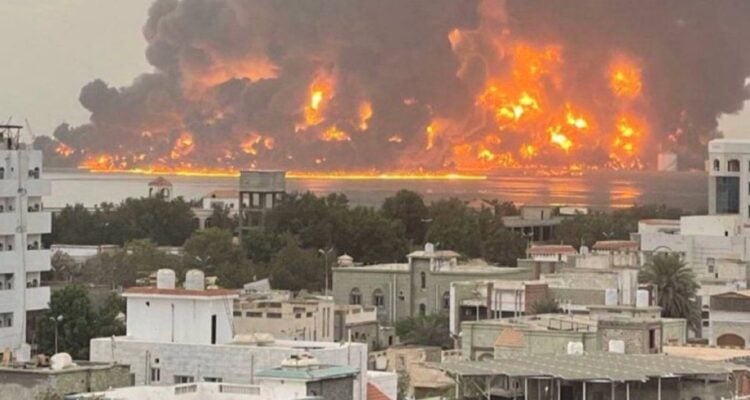The Houthis have been provoking the IDF, which has been preoccupied with more immediate and pressing conflicts; however, with Syria largely stabilized, the IDF can now redirect its focus to Yemen.
By Lilach Shoval, JNS
The Israeli Air Forces remains uncertain whether Yemen’s Houthi rebels launched three or four unmanned aerial vehicles (UAVs) toward Israel on Thursday morning. What is clear, however, is that the Houthis have increased their attempts to challenge Israel in recent days.
One of the drones was intercepted near Eilat, another was downed using soft-kill methods and a third disappeared from radar and has yet to be located.
According to Israel Defense Forces assessments, the escalation of Houthi attacks is partly due to the significant blows sustained in recent weeks by Iran’s “axis of evil,” with the Houthis attempting to exploit the situation to assume a leading role.
Israeli officials acknowledge that the situation cannot continue and are preparing for the possibility of a third significant strike against Houthi targets in Yemen.
Evaluating strikes on the Syrian military
In Syria, The IDF continues to analyze the results of its strikes on Syrian military assets. Current estimates indicate that 58% to 88% of Syria’s air defense systems have been critically damaged.
While IDF briefings have suggested that around 80% of Assad’s military has been damaged, senior officers caution that this figure is overly ambitious and advise more conservative estimates.
According to their analyses, overall damage to Syria’s military capabilities is lower, as intelligence does not cover every weapon system.
The operation in Syria involved the use of 1,800 munitions—none of which had been part of initial plans. The decision was made to focus on high-value assets. Since the beginning of the conflict on Oct. 7, 2023, the IAF has deployed approximately 83,000 munitions across all combat zones.
The IDF’s rapid response in Syria stemmed from the evolving dynamics of the country’s civil war. When rebel offensives raised doubts about Assad’s survival, the IDF prepared plans to target remaining Syrian military assets in rebel-held areas.
In just 48 hours, the IAF struck over 500 targets in Syria. The strikes destroyed more than 85% of Syria’s air defense systems and 40% of Assad’s fighter jets. Additionally, 100% of Syria’s armed drones and 390 artillery positions were eliminated.
The timing of the operation posed a key dilemma. On one hand, Israel sought to avoid being seen as interfering in Syria’s internal affairs.
On the other, action was necessary before certain weapon systems disappeared or were relocated. Before the strikes, Russian forces had numerous air defense systems in Syria, but now only a few remain.
According to IDF data, the following Syrian air defense systems have been destroyed:
• SA-2 and SA-3 batteries (100% destroyed)
• SA-22 and SA-6 systems (86%)
• SA-17 batteries (80%)
• SA-8 systems (77%)
• SA-26 systems (66%)
Overall, 86% of Syria’s air defense systems have been neutralized, enabling the IAF to operate almost freely over Syrian territory. In the past, strikes were conducted from a distance using long-range munitions.
Now, the destruction of 100% of Syria’s armed drones, along with 90% of its MiG-39 and 80% of its Su-24 fighter jets, ensures greater operational flexibility.
The IDF also targeted sites believed to house chemical weapons, but intelligence gaps suggest that some stockpiles may remain undetected.
Escalating threats on Israel’s northern front
Since the start of the war, over 22,000 rockets and missiles have been fired at Israel, including 12,300 since the launch of “Operation Northern Arrows” against Hezbollah in Lebanon.
Of these, 900 rockets landed in Israel, though only 12 caused significant damage. The IDF reports a 91% interception success rate.
UAV threats persist as well. Since the conflict began, 648 UAVs have been launched at Israel, including 239 since “Operation Northern Arrows” commenced. While 94% have been intercepted, the remaining threats continue to trigger sirens and unsettle the public.
Israeli strikes have targeted all land crossings between Lebanon and Syria except the main route between Beirut and Damascus. The objective: preventing the transfer of weapons from Iran to Hezbollah or the movement of remaining Syrian military assets.
However, it is likely some smuggling routes remain active and undetected by Israeli intelligence.
Looking ahead, 2025 is expected to center on Iran, with the Israeli defense establishment preparing for potential conflict with Tehran and its regional proxies. The IDF continues to strengthen its readiness for addressing the Iranian threat at all levels.





